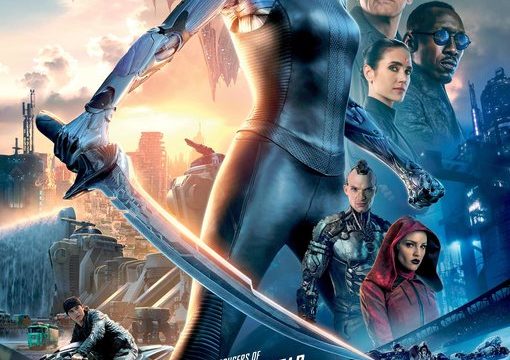After more than two decades of production, Alita: Battle Angel has finally made its way to the big screen. A long-time passion project for James Cameron, the filmmaker behind Avatar has turned over the directorial reins of Alita: Battle Angel to Robert Rodriguez, though a number of fixtures of Cameron’s 21st-century artistic passions can still be found in the film (after all, Cameron still wrote the script), primarily the use of a protagonist brought to life through motion-capture animation. Fusing together the sensibilities of the director of Titanic with the director of Machete turns out to result in a movie that’s agreeable but not quite outstanding.
Based on a popular manga series by Yukito Kishiro, Alita (Rosa Salazar) is a cyborg who is reawakened by a kindly scientist named Dr. Dysen Ido (Christoph Waltz). Alita has had her entire memory wiped away, so she has no clue who she is. Though her identity is a mystery to her and Ido, her new father figure explains to her that she lives in Iron City, a junkyard land filled with violence and depravity that lives beneath the wealthy city of Zalem. It’s tough to live out here in Iron City but Alita has some skills up her sleeve that might unlock the secrets of her past as well as make her a righteous champion for the downtrodden.
Though the shortcomings of the screenplay by James Cameron and Laeta Kalogridis will be discussed in due time, the best part of the script is how it makes Alita a character worth rooting for and getting engaged in. Framing Alita’s story of coming to terms with what she’s capable of as a teenage coming-of-age story is a clever touch while her gung-ho attitude towards using her gifts to help others mixed together with her amnesia make her a cross between Captain America and Jason Bourne, a mixture that works much better in execution in this context than I would have expected. Plus, it’s a character that Rosa Salazar does quite well in performing, particularly in her depictions of Alita flipping from normal person behavior to assured legendary warrior on a dime.
In the context of the film as a whole, Alita working so well as a protagonist is a bit of a surprise since characters tend to be a weakness for the screenplay. The villainous Vector, for instance, isn’t that interesting of a villain since he’s constantly framed as a glorified henchman to an off-screen foe residing in Zalem. The part feels like a total waste of the talents of Mahershala Ali and a similar fate befalls Jennifer Connelly in the underwritten part of Chiren. But not all the supporting characters here come up short, Dr. Dysen Ido, who is presumably just coming off a case of Tulip Fever, allows Christoph Waltz to play a more nuanced character than his usual blockbuster movie roles while a pair of robotic baddies played Ed Skrein and Jackie Earl Haley make for delightfully over-the-top foes for Alita to face off against.
Skrein and Haley’s characters, like Alita, are brought to life through outstanding motion-capture animation that ensures the robotic co-stars inhabit scenes with live-action characters in a totally organic fashion. They’ve also opted to just let the voices of the actors come out of their motion-capture characters without any digital auditory modulation, which really helps sell these robots as characters with discernable personalities. Also impressing on a visual level is the design choices for the robots which opt for nifty-looking gadgets, gizmos and body shapes that are more concerned with pushing as many buzzsaws into one person’s arm than whether or not these designs are practical. And yes, the controversial choice to have Alita’s eyes be noticeably big works well in execution, I never even noticed a few minutes into the film (though I never really had a problem with her eyes in the marketing for this movie, so your mileage may vary).
As a visual spectacle, Alita: Battle Angel does deliver, as one would expect a movie produced by James Cameron to. This even extends to the action scenes, which avoid becoming a mish-mash of incoherent robotic noise like in the majority of the Transformers movies. Instead, the second-unit team and editors keep things visually coherent even during one fast-paced set piece set during a robotic rollerblade championship that serves as the movies equivalent to the Flesh Fair from A.I.: Artifical Intellegence. The aforementioned well-realized designs of the robots that make sure Alita and the other robotic characters look distinct from one another certainly comes in handy during these action scenes.
After so many dazzling set pieces, it’s a pity that Alita: Battle Angel opts for a more small-scale climax that tries to do a big confrontation between Alita and Vector that just doesn’t have much thematic heft to it since these characters haven’t interacted before now. It’s an odd storytelling choice that ends things on a sour note and just one of a number of clumsy storytelling decisions (including an oddly executed unearned conclusion to Connelly’s character arc) found throughout the script. At least the screenplay for Alita: Battle Angel managed to get its lead character right, but its awkward handling of other key plot points and characters drags down what’s otherwise a pretty agreeable and visually impressive movie. It’s certainly a massive step up in quality from the last Robert Rodriguez directorial effort, that Sin City sequel everyone except for Frank Miller forgot about.

